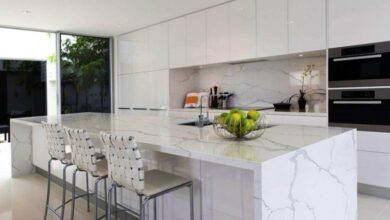Introduction
When it comes to kitchen interior design, the possibilities are endless. From the colors on the walls to the layout of the cabinets, every decision plays a role in creating a space that is not only visually appealing but also functional. In this unconventional guide, we will explore unique and informative ideas to help you redesign your kitchen with purpose.
Exploring the Psychological Impact of Color in Kitchen Design
Color plays a pivotal role in shaping our kitchen experiences, subtly influencing our mood and behavior. Imagine stepping into a kitchen bathed in soft, buttery yellows – it evokes a sense of warmth and welcome, doesn’t it? Conversely, a kitchen adorned with shades of serene blue may usher in a tranquil atmosphere, reducing feelings of stress. The strategic application of color in kitchen interiors is more than just an aesthetic decision; it’s a tool that can significantly alter the emotional landscape of the space. When selecting colors for your kitchen, consider not only the visual harmony but also the type of emotional ambiance you wish to cultivate. For instance, a splash of vibrant green can inject vitality, ideal for spaces where morning energy is paramount. On the other hand, incorporating earthy tones can ground the space, fostering a sense of stability and calm. By thoughtfully choosing your palette, you embark on a journey to create a kitchen that doesn’t just cater to the functional aspects of cooking and dining but also nourishes the soul.
Integrating Technology Seamlessly for Modern Functionality
In the realm of kitchen interior design, the harmonious integration of technology stands as a testament to modern innovation. The kitchen, traditionally seen as the heart of the home, has evolved into a hub of digital advancement. This evolution brings with it an array of smart appliances and gadgets designed to streamline culinary tasks and enhance user experience. Consider, for instance, the convenience offered by a refrigerator that can keep track of grocery needs or an oven that preheats at the command of your voice. Such technological incorporations do not merely serve functional purposes; they redefine the essence of kitchen interiors, marrying aesthetics with practicality. As you venture to infuse your kitchen with the latest technological offerings, focus on solutions that blend with the space’s design ethos. The objective is to achieve a seamless aesthetic flow, where technology enhances rather than interrupts the visual continuity of the kitchen. Embracing technology in kitchen design is about crafting a space that is not only in tune with the times but also anticipates the future, ensuring your kitchen remains a place of comfort, convenience, and cutting-edge innovation.
Sustainable Practices in Material Selection and Layout
Embracing sustainability in kitchen interior design goes beyond a trend; it is a commitment to fostering a healthier planet and living space. Selecting materials that honor this commitment can transform your kitchen into a testament to eco-conscious living. Imagine surfaces gleaming with recycled glass countertops, cabinets crafted from reclaimed wood, and floors laid with natural, renewable bamboo. These choices not only reduce the environmental impact but also add a narrative of responsibility and care to your kitchen’s aesthetic.
The layout of your kitchen plays a crucial role in its sustainability. Designing a space that maximizes natural light reduces the need for artificial illumination, thereby conserving energy. Strategic placement of appliances can also enhance efficiency, cutting down on water and electricity usage. Consider, for instance, the ergonomics of your kitchen triangle—the sink, stove, and refrigerator. A well-planned layout minimizes wasteful movements and energy expenditure, streamlining your cooking processes in an eco-friendly manner.
In this journey towards sustainability, every material selection and layout decision contributes to a broader vision of environmental stewardship. By integrating eco-friendly practices into your kitchen design, you’re not just creating a space that looks good—you’re also making a positive impact on the world around you.
Personalizing Spaces with Unique Textures and Patterns
The dynamic interplay of textures and patterns holds the key to infusing your kitchen with unparalleled character and depth. Envision the tactile variance of a smooth, polished marble countertop against the rustic charm of a rough-hewn wood island. Or imagine the visual intrigue created by geometric tile patterns juxtaposed with the organic lines of natural stone flooring. This exploration of contrast not only elevates the aesthetic complexity of the space but also reflects a narrative uniquely your own. As you embark on this design journey, consider how the inclusion of distinctive textures and patterns can serve as a reflection of your personal taste and style. Whether it’s through the subtle grain of eco-friendly bamboo cabinets or the bold statement of a patterned backsplash, these elements offer an opportunity to weave together a tapestry of design that speaks directly to the soul. In embracing such diversity within your kitchen’s design, you cultivate a space that is not just seen but felt, creating an atmosphere that resonates with warmth, creativity, and individuality.
The Art of Maximizing Small Kitchen Spaces
Navigating the design intricacies of compact kitchens necessitates innovative thinking and a keen eye for detail. Every square inch holds potential for creativity and efficiency, transforming limitations into opportunities. Consider the magic of vertical storage solutions: hanging pot racks, magnetic knife strips, and tiered shelving can elevate your storage strategy, freeing up precious counter space. Innovative, foldable furniture pieces offer flexibility, providing a work surface when needed and tucking away neatly when not in use. Moreover, the judicious use of lighting can alter the perception of space, with under-cabinet lighting and strategically placed task lighting creating an illusion of depth and openness. Embracing reflective surfaces, such as glossy backsplashes or metallic finishes, can also play a role in visually expanding the area, bouncing light around the room to create a more airy feel. By focusing on these smart design solutions, small kitchens can be meticulously crafted to not only meet the demands of daily life but to delight and inspire those who navigate them, proving that great design is not constrained by size.



